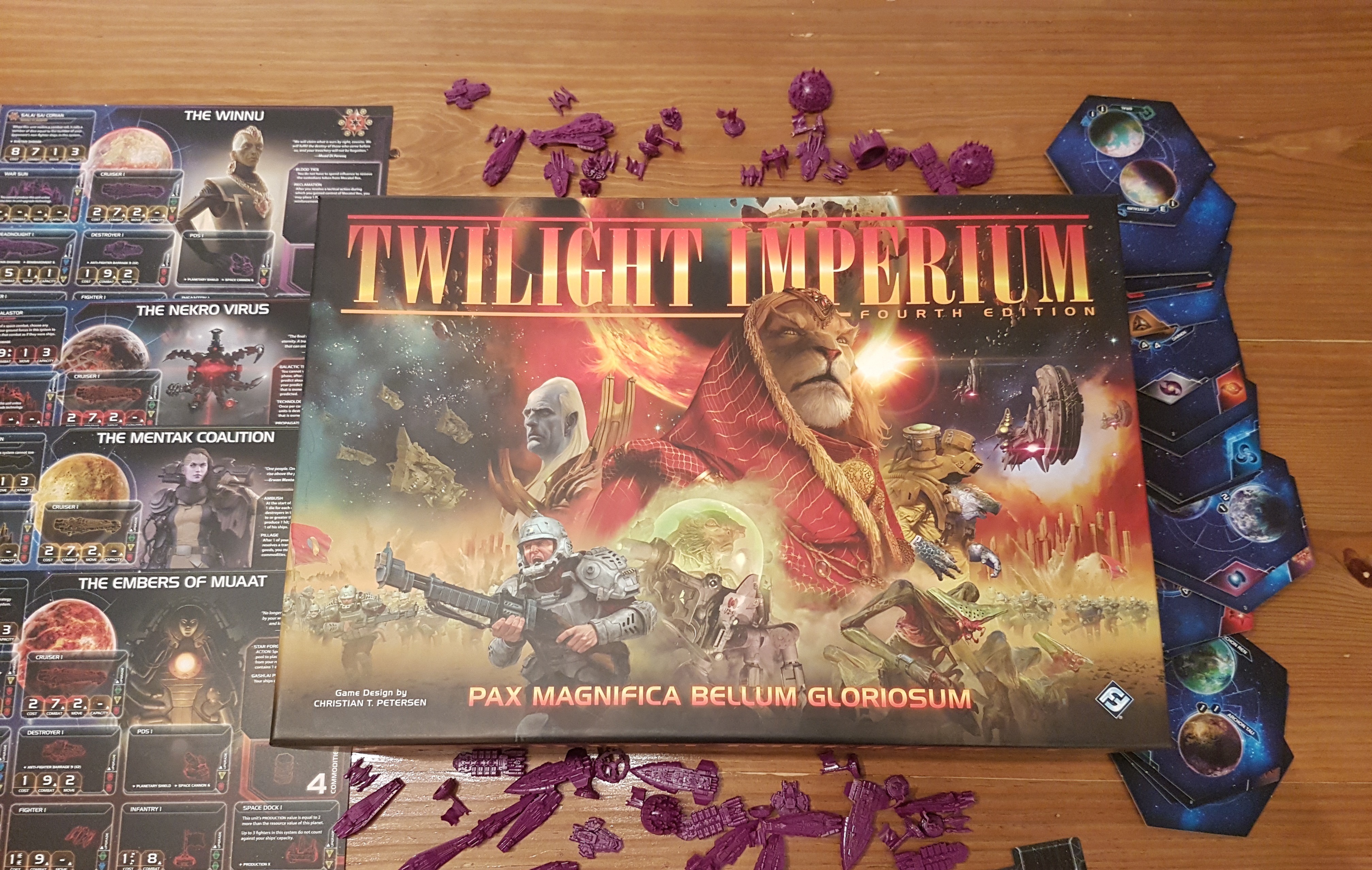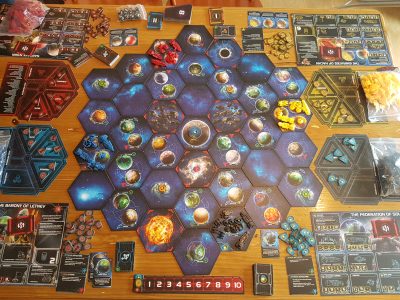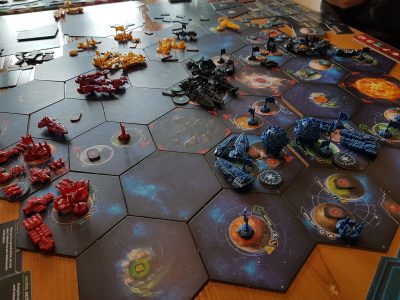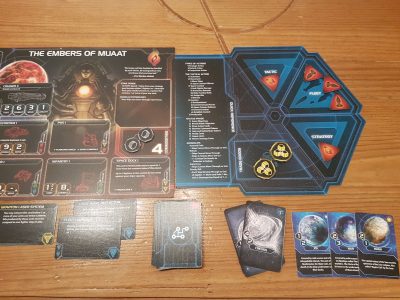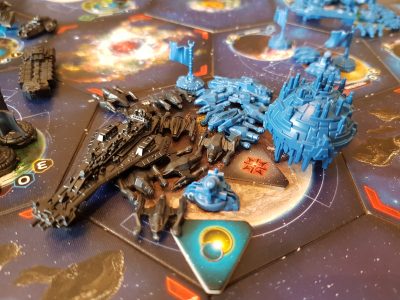The original Twilight Imperium was released back in 1997. 20 years on and the fourth edition of the colossal galactic conquest game has just been released. For 3 – 6 players the game sees each player take up the leadership of one of the 17 included races as they battle it out in space. Fantasy Flight Games has made a new wave of refinements for the fourth edition. However, this is for those new to the franchise from the perspective of someone getting into the franchise for the first time. So, how does Twilight Imperium Fourth Edition play?
Firstly, player order is not determined by where you are sat around a table instead each round starts with players choosing Strategy cards. Each strategy card has a unique primary ability that can be used in the action phase, as well as a secondary ability which others can use. Each also comes with a number, 1 – 8. It is these numbers than determine the turn order. This creates a dynamic where players can almost treat turn order as a commodity: a trade-off between how early they will get to go against a potentially more advantageous ability. The only issue is all the abilities can be brilliant, so players do have to ponder on this decision. For those of you who have played Stonemaier Games’ Viticulture this is a very similar to the Spring turn order system.
The majority of turns will see players activating a system on the board. Each system can, by default, only be activated once per round. Some abilities allow for the removal of command tokens, therefore allowing for re-activations. Depending on their ships’ stats a player can move X number of systems into the activated system, transporting with them Y units (ground units and/or fighters) based on their capacity. If a ship can move to the activated system, and their fleet allows them to have that number of ships in a single system, the player can them move it there. If no one else occupies that system they can drop ground troops to take control of any planets. Twilight Imperium is however all about when others are already in that system.
If you’re ships enter a hex with opponents ships then combat ensues. Combat also follows a distinct order and keeps going until either only forces from one player remain or one player retreats. Retreating isn’t just as simple as running away though as you are still drawn into the current round of combat as you try to escape. Players must state they are retreating at the offset of the combat phase. Next, shots are fired from both fleets. Utilizing 10-sided dice players roll a single die for each of their ships. The threshold to determine if a successful hit has been made depends on the combat stat of the type of ship.
Assigning hits is an interesting mechanic which sees cheaper ships become cannon fodder. When an opponent lands a hit you get to choose which unit gets destroyed. This removes the necessity for health pools on larger ships, something that may take the amount of keep track of from a metric tonne to too much. The sweet spot certainly has been found, keeping the game still intensive but not a cluster of thousands of individual tokens. After hits have landed and only then does a retreat occur. This sees that player jump all of their surviving ships to an adjacent tile. If neither player has retreated and both still have units in the system the combat round starts again from the top. A planet can be invaded even if it has enemy ground forces on it. This uses very similar mechanics to space based combat with players rolling dice to land hits on the opponent’s forces. At the end of ground combat, the victorious player gets/keeps the planet card.
There are a range of abilities that can affect space based combat such as Anti-Fighter Barrage and Space Cannon. On the planetary side of things skills such as Bombardment and again the Space Cannon can alter the otherwise “basic” rules. These are all dependent on the ships in orbit and structures build planet-side and therefore are on a case by case basis. As with much of this game there are multiple ways to do things and finding those perfect combinations for fleets is all part of the fun.
Controlling planets gives players access to resources, influence and sometimes the ability to make technological advancements cheaper. Resources are spent to produce new units at players’ space docks throughout their empire. Each planet has a resource value which they can be exhausted for. For example, The Federation of Sol’s (the human race’s) Advanced Carrier I has a cost of 3. To be able to build this a planet with a resource value of 3 or higher, or two/more planets of resource value totalling of 3, need to be exhausted. Trade goods can be used instead, more on those in a bit.
The game may allow you to dominate the many systems, churn out ships and participate in huge space battles but how do you win? The simple answer is victory points. There are many ways to earn victory points and in a regular game it is first to 10, though a longer 14-point game can be selected. At the offset of the game two tier 1 objectives are revealed. At the end of each round of the displayed public objectives can be completed by players. One can also be completed during a round by the player whom took the Imperial strategy card. Once an objective has been scored by a player they place a control token on the objective card to show they have already completed it and move up by the number of victory points denoted on the objective card.
Tier 1 objectives award 1 victory point, while Tier 2 objectives award 2 victory points. As you can probably guess Tier 2 objectives are a decent amount harder to complete. An example of this is one Tier 1 card is to control 6 non-home system planets, while a similar Tier 2 objective is to control 11! Once everyone has completed a possible objective the board is cleared of command tokens, each player gains two new command tokens and a new objective card is revealed. If Mecatol Rex has been taken this is when the Agenda phase would begin otherwise it is back up to the start of a new round, commencing with the speaker choosing a strategy token.
To spice up the game secret objectives are included. These range from controlling specific wormhole systems or winning a battle involving your flagship to researching both race specific technologies. I find these often seemed to encourage aggressiveness, at least to some extent, between players. Perhaps these are just the ones I try to complete… Some of these will be scored in the status phase alongside the public objectives, with others will be completed as soon the action has occurred. Only three secret objectives can be scored per player and they can see the game ending mid-round.
The Agenda phase is added into the game as soon as Mecatol Rex is taken by a player. This seems to occur at earliest in the third or fourth round, allowing new players a few rounds without agendas to pick up the rest of the ruleset. After the first game it allows players to build up forces, take planets and develop a game plan before laws are thrown into the mix. On top of this the game gets flowing nicely and players start to see if the outcome of laws would actually benefit them.
The agenda phase is last in the phase order, just before planets are un-exhausted. During each agenda phase two laws will be voted on. The first law is read out by the speaker and then votes can be cast utilizing the influence stat of planets. Once complete the second law is revealed and voted on. This gives an interesting dynamic to voting on the initial agenda as you often don’t fully commit all your influence to a cause, in case the second agenda is more impactful. Laws alter the basic rules of the game, sometimes adding value, sometimes spoiling your party. This phase is the only time non-neighbouring races can trade and barter. Using commodities, trade goods or future promises players can look to buy votes from others to further their cause. The only limitation is one player can only vote one way for each outcome.
Laws can affect individual planets or players, where voters will have to nominate one for the law to affect, or everyone and the galaxy evenly. Some examples of interesting laws include making a planet a demilitarised zone, reducing the number of fighters produced at once from two to one for all players and even removing the limit of planetary defence systems allowed on a planet. Though the last one did encourage a turtling strategy. In your first game it does seem to some extent that just after getting used to the rules tweaks start happening. In games after this though their impact becomes obvious and how the ability to have different laws affecting the game drives replayability. To all intents and purposes, no two games will be alike, all it takes is one vote to go a different way and something new is thrown into the mix.
Before the first game I set up the table in advance with help from the board layout diagram from the rulebook. As well as this I set up the colours for the players so only race content needed to be selected. Including this time and the time spent after players had arrived and selected a race it took well over 30 minutes to set the game up. Note, this does not include the time it took to pop all the cardboard tokens/board pieces from the punch out sheets (a good 15 minutes). For a standard game this would be a huge issue, almost a game killer for me. If the game only lasted an hour it would be instantly discounted by many. Due to the length comfortably hitting the 6-hour mark I feel less inclined to moan, more just say it’ll take time.
Having previously never had the opportunity to dive head first into this rich and wonderful, lore-filled universe I can see why many would falter at the mere sight. Video games of a similar ilk have to some extent prepared me for the experience. Once you get past the sheer quantity of potential actions and options players have, combined with differing races which can drastically alter the optimal way to play, things become logical. These logical steps are only enhanced by the structure of turns which consistently follow the same order.
There are certainly similarities to be drawn from video games. Fans of grand space strategy games such as Sins of a Solar Empire, and to some extent the more recent Stellaris, will feel right at home within the Twilight Imperium universe. In fact, if you regularly play those sorts of video games you will be able to handle jumping into what is one of the weightiest board games out there. Naturally there are a lot of rules and intricacies to learn, though if you are used to games in any medium where you have similar number of concepts (movement, combat, control, technology and differing strengths and weaknesses based upon stats) you will most likely not be overwhelmed.

